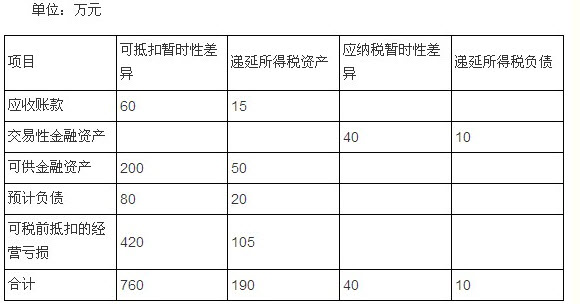甲公司为上市公司,2010年有关资料如下: (1)甲公司2010年初的递延所得税资产借方余额为190万元,递延所得税负债贷方余额为10万元,具体构成项目如下:
 (2)甲公司2010年度实现的利润总额为1 610万元。2010年度相关交易或事项资料如下: ①年末转回应收账款坏账准备20万元。根据税法规定,转加的坏账损失不计入应纳税所得额。 ②年末根据交易性金融资产公允价值变动确认公允价值变动收益20万元。根据税法规定,交易性金融资产公允价值变动收益不计入应纳税所得额。 ③年末根据可供金融资产公允价值变动增加资本公积40万元。根据税法规定,可供金融资产公允价值变动金额不计入应纳税所得额。 ④当年实际支付产品保修费用50万元,冲减前期确认的相关预计负债;当年又确认产品保修费用10万元,增加相关预计负债。根据税法规定,实际支付的产品保修费用允许税前扣除。但预计的产品保修费用不允许税前扣除。 ⑤当年发生研究开发支出100万元,全部费用化计入当期损益。根据税法规定,计算应纳税所得额时,当年实际发生的费用化研究开发支出可以按50%加计扣除。 (3)2010年末资产负债表相关项目金额及其计税基础如下:
(2)甲公司2010年度实现的利润总额为1 610万元。2010年度相关交易或事项资料如下: ①年末转回应收账款坏账准备20万元。根据税法规定,转加的坏账损失不计入应纳税所得额。 ②年末根据交易性金融资产公允价值变动确认公允价值变动收益20万元。根据税法规定,交易性金融资产公允价值变动收益不计入应纳税所得额。 ③年末根据可供金融资产公允价值变动增加资本公积40万元。根据税法规定,可供金融资产公允价值变动金额不计入应纳税所得额。 ④当年实际支付产品保修费用50万元,冲减前期确认的相关预计负债;当年又确认产品保修费用10万元,增加相关预计负债。根据税法规定,实际支付的产品保修费用允许税前扣除。但预计的产品保修费用不允许税前扣除。 ⑤当年发生研究开发支出100万元,全部费用化计入当期损益。根据税法规定,计算应纳税所得额时,当年实际发生的费用化研究开发支出可以按50%加计扣除。 (3)2010年末资产负债表相关项目金额及其计税基础如下:
 (4)甲公司适用的所得税税率为25%,预计未来期间适用的所得税税率不会发生变化,未来的期间能够产生足够的应纳税所得额用以抵扣可抵扣暂时性差异;不会考虑其他因素。 要求: (答案中的金额单位用万元表示)
(4)甲公司适用的所得税税率为25%,预计未来期间适用的所得税税率不会发生变化,未来的期间能够产生足够的应纳税所得额用以抵扣可抵扣暂时性差异;不会考虑其他因素。 要求: (答案中的金额单位用万元表示)
根据上述资料,计算甲公司2010年应纳税所得额和应交所得税金额。
参考答案:
应纳税所得额=会计利润总额1610+当期发生的可抵扣暂时性差异10-当期发生的应纳税暂时性差异20-当期转回的可抵扣暂时性差异(20+50)+当期转回的应纳税暂时性差异0-非暂时性差异(100×50%+420)=1060(万元) 注释: 当期发生的可抵扣暂时性差异10指的是本期增加的产品质量费用计提的预计负债10产生的可抵扣暂时性差异。 当期发生的应纳税暂时性差异20指的是年末根据交易性金融资产公允价值变确认公允价值变动收益20导致交易性金融资产新产生的应纳税暂时性差异。 当期转回的可抵扣暂时性差异(20+50)指的是本期转回的坏账准备而转回的可抵扣暂时性差异20以及实际发生的产品质量费用50转回的可抵扣暂时性差异50。 非暂时性差异(100×50%+420)指的是加计扣除的研发支出100×50%以及税前弥补亏损金额420。 应交所得税=1060×25%=265(万元)。
